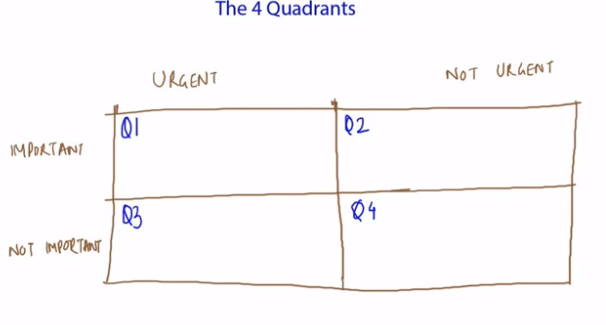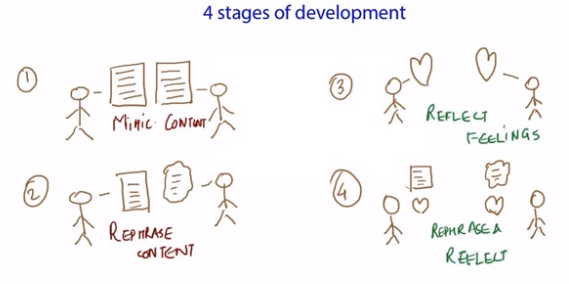The 7 Habits of Highly Effective People by Stephen Covey | Book Summary & PDF
In The 7 Habits of Highly Effective People PDF summary you will learn:
- How to respond to external stimulus or situation
- Developing a personal mission statement to create your reality
- Using the 4-Quadrant Framework to your advantage
- A process to think “win-win” and to be highly effective
- How to create your own emotional bank for influencing others
- Steps to create an environment for synergy
- Life’s domains that need constant renewing
SUMMARY
Habit 1: Be Proactive

The following are the key differences between proactive and reactive people:
| REACTIVE PEOPLE | PROACTIVE PEOPLE |
| The external stimulus or condition causes them to respond in a certain way. | They create that space between stimulus and response
|
| They blame the conditions or circumstances. | The freedom to choose is directly related to their values, character, will, or conscience. |
They act based on feelings as a result of the stimulus.
|
Their responses will be a result of what they choose rather than the stimulus. |
To be proactive, we cannot react to the circumstances as they are. We have to process them and then act according to —
- our own values
- our character
- our will
- our conscience
SCENARIO: Someone says or does something (external stimulus) that a reactive person would feel bad about.
The proactive person, despite the stimulus or behavior of the other person, would stop to process the situation and check his values (e.g. courage, learning and growth, ambition) and probably ask questions such as:
What can I learn from this situation?
When he realizes that he is learning (i.e., how to handle angry people), he might respond with a different demeanor.
Remember: The key and powerful difference between being proactive and being reactive is the freedom to choose how to respond to a situation rather than just responding blindly.
Circle of Concern vs. Circle of Influence
The Circle of Concern and the Circle of Influence can help us further understand how reactive and proactive people act.
Circle of Concern – the overall area covering our concerns in life
Circle of Influence – a circle inside the Circle of Concern containing all the things we can control and directly influence
| REACTIVE PEOPLE | PROACTIVE PEOPLE |
1. They focus a lot on things they cannot control such as:
|
1. They focus exclusively on:
|
| 2. Their Circle of Concern continues to increase, while their power, or circle of influence, diminishes | 2. Their Circle of Influence gets bigger and they become a lot more productive. |
| 3. They become less proactive and more reactive as their circle of influence decreases | 3. They can handle a lot more in life when their focus is on their circle of influence. As a result–
|
Habit 2: Begin with the End in Mind

Any man-made creation we see in this world was first a creation in the mind before becoming a reality.
EXAMPLE: The house you’re living in was at first someone’s mental creation before it became a reality.
- Someone laid out the blueprint
- Someone put it in the software or maybe on paper
- Someone built the house
While some people create a life out of their own conscious design or out of their own volition, others live their life as a result of other people’s judgment, agenda, and opinions.
That is living by default. Such life is exemplified by people who are —
- running around like robots
- never thinking about what they want to create in their lives or who they want to become in this world
To become highly effective, we must begin with the end in mind. Understanding that we are the creators of our own world or the writers of our life’s program enables us to create it.
The way we can start the whole process is to develop our own personal mission statement — our own philosophy or creed.
Personal Mission Statement
- Focuses on
- who we want to be and what we want to do
- what we want to accomplish
- our contributions and achievements
- Comes from our values and principles
- similar to how a country’s constitution is written (e.g., The American Constitution)
- Profound and written in a way that inspires us
- Stephen Covey says that in a world that’s constantly changing, we must have a core inside us that’s stable so that we can meet the challenges of this world. People can’t live with change if there isn’t a changeless core inside of them.
- Can evolve over time
- We may not have the perfect understanding at the beginning, but a personal mission statement is not something that’s done overnight.
- Like a program, it needs to be repeatedly rewritten to accommodate changes over time.
- In his book Total Focus, former Navy SEAL Brandon Webb also talks about the idea that a mission will evolve as we may not know everything right off the bat.
2 Tools for Programming Ourselves
1. Affirmation – To write a good affirmation, the following qualities of it are key:
- Personal
- Positive
- In present tense
- Visual
- Emotional
These are standard practices for writing a good affirmation. Repeat them to yourself and visualize them.
2. Visualization – Things you would want to visualize:
- Your future
- Your mission statement
- Your final outcome
Use these tools in writing the program into your mind so that you can start to operate on it.
Remember: First we were the creators. Now we are creating the program that will create the blueprint of our reality, our new version.
Read:
- Total Focus – Brandon Webb
Habit 3: First Things First
So far, we have these analogies:
- Habit 1 showed us that we are the programmers
- Habit 2 showed us that we have to write the program and that we have to begin with the end in mind. We have to know exactly what we need to get.
- Habit 3 is showing us that we need to run the program in a way that we get the results we want.
Our values and mission are critical to our execution of the program. They should drive the program, rather than us focusing on our willpower to get things done. Having that burning WHY or desire is critical.
Fundamental Question to Ask Ourselves: “What is that 1 thing I could do in my business or personal life which, if I do on a regular basis, would create a gigantic difference and would completely change my life into something great?”
Our answer to this question is what we need to focus our energy on.
When we ask someone, “Why are you not following through on your commitments on whatever you said you wanted to do?” — follow up with these questions:
- Is it because you’re unable to prioritize?
- Is it because you feel like the desire to work on these priorities is not there?
- Do you feel like there is a lack of discipline to execute?
Most people would answer No. 3 (lack of discipline to execute), but the truth is that we lack desire.
Our mission and our goals and dreams are not burning inside of us. Here’s another analogy to help us understand this idea.
Parts of a Tree
- Roots = our mission, values, and goal
- Leaves = discipline and willpower
In order for us to grow the tree, we should constantly work and focus our energy on our roots. Working on the leaves and making it the primary focus will not work.
How to Execute First Things First
Here’s a simple tool to visualize what you do on a day-to-day basis and to evaluate which among the activities stands out to be the first one you should do. This tool is made famous by Stephen Covey and it works as follows:
The 4-Quadrant Framework

Draw a table. On the x-axis, plot areas as “Urgent” and “Not Urgent.” On the y-axis, plot the areas as “Important” and “Not Important.” Divide the table into 4 boxes namely:
Quadrant 1 – Urgent and Important
Quadrant 2 – Not Urgent and Important
Quadrant 3 – Urgent and Not important
Quadrant 4 – Not urgent and Not important
What you will realize is that:
- Most of the time you are focusing on items in Quadrant 1 (Urgent and Important) and Quadrant 3 (Urgent and Not important).
- Sometimes you also focus on things in Quadrant 4 (Not urgent and Not important).
- You easily let go of things that are in Quadrant 2.
The problem with Quadrant 2 is that while items here are not urgent, they are important. They build up or accumulate over time when they are neglected. This could cause a toll and as a result, our life would turn in the wrong direction.
This is why we need to do First Things First.
Q2 examples:
- Being strategic about our business by thinking about our long-term vision.
- Spending time with our family.
- Working out and keeping the body in good shape.
- If you do not exercise today or tomorrow, nothing bad will happen to your body. But if you do not exercise for a long period, over time your body will deteriorate.
The most important quadrant: Quadrant 2. All the things that we are not pushing for right now, just because they are not urgent, are critical for our long-term success. They are the things we need to focus on. Examples:
- Meditation
- Exercise
- Working on our relationships
- Working on our business
Paradigms of Interdependence
When it comes to working with people, here’s a question we can ask ourselves.
What is the most important ingredient we put into a relationship?
Some possible additional questions:
- Is it the words we say?
- The things we do?
- Is it who we are?
Who we are is the most important ingredient because being congruent with ourselves, our character, and our ethics will make us do the right things.
On the other hand, being incongruent with ourselves by acting and trying to be someone else will destroy that relationship. It will not create the paradigm of interdependence.
Emotional Bank Account
An emotional bank account is the amount of trust we’ve built up in any relationship. This allows other people to feel safe around us.
A high emotional bank account means that communication with a person is
- easy
- instant
- effective
The most important deposit we can make to an emotional bank account: the effort to understand the person
- We should consider what’s important to them as important to us too.
- We should not project our own needs to them and assume it’s what they like or what they feel is important.
- Accept that we are all different.
Remember: We need to constantly make deposits in this emotional bank account in order to have powerful relationships.
Habit 4: Think “Win-Win”
Win-Lose Scenario – Thinking how you can win without thinking how the other person can win
Lose-Lose Scenario – Making sure the other person loses no matter what
Win-Win Scenario – Thinking how you and the other person can win
To be highly effective, we need to think Win-Win.
4-Step Process to Thinking “Win-Win”
- See the problem from the other person’s perspective.
- Identify the key issues and concerns they might have.
- Determine the results that can be acceptable for both of you.
- Identify possible options to achieve those results.
Take note that the whole process starts by thinking from the other person’s perspective.
???? ACTION ITEM:
Applying this process in the paradigms of your life, here’s what you can do for a win-win thinking:
- Make a list of obstacles that keep you from applying win-win in any situation.
- Think of what you can do within your Circle of Influence that will eliminate some of these blocks.
- Select a specific relationship where you would like to develop a win-win relationship.
- Put yourself in the other person’s shoes.
- Write down explicitly how you think that person sees this situation.
- Think about your own perspective and what results would be acceptable for you.
- Finally, approach the other person and ask if they would be able to consider the situation where both of you would win.
Remember: Before applying this in the relationships you’ve identified, think about how you can make emotional bank deposits so that the other person will be more open to your perspectives and ideas of how to achieve a win-win situation.
Habit 5: Seek First to Understand, Then to Be Understood
The key to Habit #5: Genuinely wanting to do well for the other person
To be influential, we should seek the welfare of the other person. This is within our circle of influence.
4 Development Stages of Empathy/Listening

- Mimic content – Whatever the other person says, we say it back.
- Rephrase content – The person says something and we rephrase it in our way.
- Reflect feelings – We understand what the person feels and we are able to tell them about it.
- Rephrase and reflect – We are able to say what the person said in our own words. We are able to reflect their feelings.
That’s when we know we truly understand someone and we can get to that person.
Seeking first to understand before being understood is a fundamental law of influence.
- Unless you can make the other person feel liked, appreciated, listened to, and understood, you can’t expect to be liked, appreciated, listened to, and understood.
- Understanding and appreciating others first are some ways of making emotional deposits. On the other hand, when you keep trying to prove how great, amazing, and awesome you are, you are completely failing.
- A good paradox: “If you want to influence someone, you must be influenced by them.”
- Empathic listening is not about merely listening and agreeing with other people. It’s about listening with the intent to understand — again, a huge act of making an emotional bank account.
EXAMPLE: If you’re a salesperson, it’s important that you first diagnose your client’s pain before you prescribe.
An effective salesperson always seeks to understand first. They understand the law of influence.
Habit 6: Synergy
Synergy is when the whole is greater than the sum of its parts.
“That which is most personal, is also the most general.”
– Carl Rogers, philosopher
The more authentic we become regarding our personal experiences in ourselves —
- the more people will relate to us
- the safer it makes them feel to express themselves to us
Levels of Communication
- Defensive – A lot of times we think defensive by thinking win-lose or lose-win.
- Compromise – Sometimes we think of compromise, which may be respectful, but both sides don’t win much.
- Synergistic (win-win) – With synergy, we’re always winning with the other person.
As the whole is greater than the sum of its parts, 1+1 is not equal to 2 but a hundred or even thousands.
A synergistic solution when we’re working with someone else is usually the best solution.
Creating the Perfect Environment for Synergy
- Create an emotional bank account with another person by wanting to understand that person.
- Think win-win with that person.
- Seek always to understand
- be empathetic
- be influential
Doing the above 3 steps not only creates an environment for synergy but also creates exponential results, given that the whole is greater than the sum of its parts.
Important: Everyone is different, and we all look at the world differently. We should be able to see and respect the other person’s point of view or understand where they’re coming from. That is how we can be truly synergistic.
Habit 7: Sharpening Your Saw
Two men are out in the jungle trying to cut a tree. One of them has a sharp saw while the other man has a blunt saw. Who will be able to saw the tree down quickly?
Obviously, the person who has the sharper saw is the one who can cut down the tree quickly.
Most of us go through life with a very dull saw. The dull saw may represent the following:
- ourselves
- our mind
- our emotional well-being
- our physical well-being/our body
- our spiritual and mental condition
If we wish to be highly productive, we need to sharpen our saw by constantly renewing all the different dimensions of our life.
We need to cultivate some daily private rituals that allow us to have victories in the following different domains (with corresponding examples):
- Physical domain
- exercise
- eating well
- sleeping well
- Spiritual domain
- being aware of our values
- using meditation or prayer
- Mental domain
- constantly improving the mind (e.g., feeding the mind by reading or watching these summaries)
- visualizing ideal outcome and future
- learning new things
- Social and emotional domain
- volunteering or helping others out
- building relationships
- working synergistically with other people
- showing empathy
All of these things sharpen our saw on a daily basis.
???? ACTION ITEM:
- Identify specific activities you can do in each of these 4 domains.
- Put them on your calendar.
- Do them on a weekly basis. (You may start with 1 activity in each of these areas and then over time you can add to them.)
- Examples of powerful keystone activities that you can employ in your life:
- Meditation
- Exercise
- Reading
- Building powerful relationships
- Watching these summaries
Related Readings:
- Be the Best at What Matters Most by Joe Calloway
- Getting Things Done by David Allen
- Total Focus by Brandon Webb
